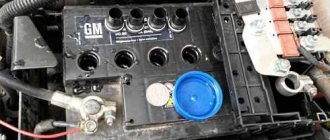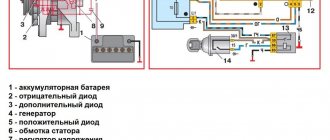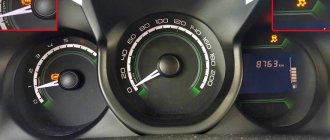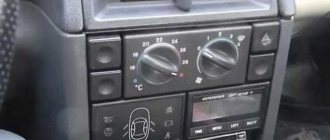The main purpose of the battery warning light
The indicator in question is designed to let the driver know whether the battery is charging or whether the entire electrical network is powered directly from the battery while driving.
When the ignition is turned on, all warning lamps light up; when the engine starts, all indicators should go out. In this case, the battery charging system is working properly and there is nothing to worry about.
Otherwise, if the battery lamp still lights up, then you should look for a malfunction.
The battery light is on - what does it mean?
There can be only one reason why the battery warning light comes on while the engine is running - there is no voltage supply from the generator or its value is insufficient.
The main malfunctions that lead to this:
- Lack of quality contact at the battery terminals.
- Damage to the alternator belt or loose tension.
- There is no negative contact with ground.
- An open circuit in the rotor excitation circuit or worn brushes in the generator.
- Failures of the diode bridge are usually accompanied by a dim lighting of the battery light on the dashboard.
- Fuse failure.
- Malfunction of the relay regulator.
Before you start troubleshooting, pay attention to why the lamp is on. If there is no voltage supplied to the battery at all, then the lamp lights up correctly. In another situation, the operation of the signal indicator while charging is present significantly complicates the problem.
First of all, determine whether there is voltage on the battery. To do this, take a voltmeter (multimeter), start the engine and measure the required characteristic at the battery terminals.
If everything is in good condition, you will see readings in the range from 13.6 to 14.2 V. In this case, the battery is charging properly. If the results obtained differ significantly from normal, then there is some kind of breakdown in the system.
The battery charging light is on
When you start the engine, many different lights come on on the dashboard, one of them is the battery charging light. Ideally, it lights up as soon as you start the engine and goes out after a while. This indicates that the generator and all its circuits are fully operational and the battery receives a charge of 13.7-14.3 Volts, that is, it is charging.
However, various breakdowns often occur due to which the light bulb continues to glow, glows dimly, or does not light at all. To deal with such malfunctions, you need to understand a little about the design of the generator and the principle of its interaction with the battery.
A little theory
On our website Vodi.su we have already described in detail the design of a car generator. Let's just say that electricity is generated in it by the rotation of the crankshaft. As the speed increases, the voltage also increases, but it must be within the limits indicated above, otherwise the battery will be overcharged, which threatens the electrolyte boiling and sulfation of the plates.
To prevent this from happening, a relay regulator is installed in the rotor excitation circuit, thanks to which a stable voltage is supplied to the battery.
The signal from the generator to the warning lamp is transmitted through a fuse, which is also located in the generator itself. Accordingly, the light stays on until the generator starts working and transmits voltage to the battery.
The charge from the generator passes through:
- diode;
- regulator;
- generator brush;
- slip rings;
- winding and wiring.
Thus, if at least one of these elements does not work correctly or fails, the readings of the light bulb cannot be trusted, although charging may be supplied to the battery.
Why is the battery charging light on?
There can be a lot of reasons. So, if after starting the engine the warning light continues to burn at full intensity, most likely the alternator belt has stretched and needs to be replaced. At the same time, you can hear characteristic sounds from the engine. On Vodi.su we have also already told you how to tighten or change a belt.
The second common cause is poor contact at the battery terminals or at the terminals from the generator. Contacts oxidize over time and need to be cleaned.
Failures in the mechanical part of the rotor: the bearing fell apart, the bushings flew off. You will have to completely remove the generator, disassemble it and replace broken parts. Fortunately, you can always find a repair kit of three bushings for a VAZ-2107 or other domestic cars on sale.
Failure of the diode bridge, relay regulator. In this case, you need to check them with a multimeter, or contact a specialist. Repairs often cost more than purchasing a new generator.
Over time, graphite brushes also wear out and need to be replaced regularly. When they are worn out, the charge is not transferred to the winding, and accordingly the light bulb begins to glow dimly, although the charge is transferred, but very weakly. Use a voltmeter as a guide. If the brushes are not changed in time, the battery will constantly be undercharged, which can lead to gradual shedding of the plates.
Generator diagnostics
First of all, the voltage is measured at the battery terminals. If it is lower than required, you need to check the entire circuit step by step:
- belt tension level;
- measure the voltage at each of the generator terminals - at each terminal it should be half as low as at the battery;
- check fuses, relays, diodes;
- check the resistance in the dashboard, the quality of soldering of wires.
If it turns out that the breakdown lies in the generator itself, it will have to be removed and also checked. In particular, they first check the relay regulator, then measure the resistance of the rotor field winding using an ohmmeter. It should not be lower than 4.5 ohms. Also, using the tester, you can determine whether the winding circuit is open.
It is clear that such malfunctions cannot be avoided. However, there are simple tips to help extend the life of the generator:
- first of all, regularly check the quality of its fastening - constant vibrations lead to mechanical damage;
- Clean external surfaces from time to time;
- check the belt tension, tighten if necessary;
- quality of the rotor bearing - remove the belt and spin the rotor, it should rotate smoothly, without play or clicks.
You also need to monitor the quality of the connection of the wires to the generator and voltage regulator.
Thus, a lit battery charging light while the engine is running is a serious reason to make a diagnosis. Please note that it can also light up if you have installed a lot of additional equipment - subwoofers, lights, lights.
( 5 ratings, average: 4.40 out of 5)
Poor contact at battery terminals
Check the condition of the battery terminals and battery contact wires. It is not uncommon for oxidation to occur in these places and the contact to weaken significantly. When the lamp comes on and there is charging, this could be the cause.
In this case, the generator operates normally, voltage is supplied to the battery, but weakens due to insufficient contact. As a result, the warning light on the dashboard comes on. As a rule, the indication lights up dimly.
To fix the problem, you need to clean the terminals and contact pins. Additionally, treat these elements with a water-repellent agent.
The battery light is on - causes and troubleshooting
Hello everyone, this is the Auto Manual, and today we will talk about malfunctions of the battery, generator, on-board network, as well as other reasons why the battery light comes on on the dashboard.
Each of you has probably noticed a little red box on the instrument panel indicating the battery. We all know that it lights up when you turn the key in the ignition and goes out when the engine starts. Why is this happening? When you insert the key and turn it in the ignition, automatic diagnostics of almost all engine systems (ABS, ESP, Airbag, Check Engine, etc.) occurs; after a successful self-test, the indicators go out, which indicates the serviceability of one or another system. The same is with the battery, when it is ok, the indicator goes out, in case of problems with the battery, the battery lamp lights up.
In this article, I will talk about why the battery light is on, as well as malfunctions that can cause the battery light to light up.
Diode bridge faults
The electrical circuit is designed to convert alternating voltage to direct voltage. If a breakdown of at least one of the diodes occurs, the functional unit ceases to perform its duties. The consequence of this is the supply of voltage that does not correspond to the required indicators.
The rectifier needs to be checked when the battery charging light is on, but there is charging.
You can determine the breakdown by using a multimeter. Take a tester and connect the red probe to the positive of the bridge, and the black one to one of the contacts marked AC.
The throughput voltage for diodes (silicon) ranges from 400 to 1000 mV. If the tester shows different values, then the bridge needs to be changed. Such a unit cannot be repaired.
Fuse failure
The electrical circuit for charging the battery is protected by a fuse. This element is located in the vehicle’s mounting block and is marked as F10. However, before checking for a malfunction in this place, it is better to first read the vehicle’s operating instructions, in which you will find out the exact designation of the required element.
If the fuse fails, the battery is not charged at all. However, there are times when the warning light comes on, but there is charging.
You can check the element using a tester (the part is removed from the mounting block). If the multimeter shows that the fuse is bad, all you have to do is replace it.
VAZ 2109 battery light is on
It is not always possible to immediately understand why the battery light on a VAZ 2109 is on. It can light up brightly or dimly, constantly or intermittently. But in any case, you should not ignore this, there may be serious reasons.
The first case is that on a VAZ 2109 the battery light is dimly lit. This means that voltage is supplied to the battery, but its value is insufficient to charge. This happens due to a weakened on-board generator belt. The belt should not dangle. If you press it with your finger, the deflection should not exceed 1-1.5 cm. If it is larger, you need to unscrew the nut on the bracket and move the generator around the axis towards the motor. And tighten the nut again.
The same undercharging effect can cause oxidation of the contacts at the battery terminals or at the terminals of the generator itself. The oxide film on the metal surface creates parasitic resistance, which prevents current from passing.
The VAZ 2109 battery light also lights dimly if the voltage regulator in the generator fails . In this case, the generator does not fit into the operating range of 13.7-14.3 V, but supplies low voltage. A value of 12 V and below is no longer capable of charging the battery, since the current simply will not flow inside due to the internal resistance of the battery. If, on the contrary, a faulty generator supplies high voltage (15 V or higher) for a long time, the battery will quickly wear out and may even boil. The regulator is completely replaced and cannot be repaired. To replace it, you need to remove and disassemble the generator.
But it happens that the battery not only does not charge, but also completely powers the car’s network. The generator does not work at all, and the battery light on the VAZ 2109 is constantly and brightly lit. In this case, the battery charge will last for several hundred kilometers, in the best case scenario. The reason for this may be, again, a non-working voltage regulator. However, even a fresh regulator quickly fails if the problem lies in the generator rectifier unit.
The operation of the rectifier unit is based on a diode bridge. Diodes fail quite easily, as they are sensitive to the influence of network parameters. They pass current in one direction, rather than allowing it to pass into the generator winding. If the diode burns out, then current can flow into the winding, thereby causing it to melt, short out, and so on. If the wiring is shorted, a characteristic burning smell will appear under the hood.
How to check a diode bridge? For this you will need an ohmmeter. Based on the properties of the diode, we connect an ohmmeter and monitor the readings. The device is connected twice, with the contacts changing. The first time it should show an infinite value (the diode is locked), the second time - a value of about several hundred Ohms (the diode is open). If this is not the case, the diode is burnt out and should be replaced. All diodes of the rectifier unit should be checked, and perhaps the entire unit should be replaced at once.
The VAZ 2109 battery light often comes on due to a break in the generator stator winding. Or it could also be a shorted winding. With the latter option, a “generator howl” is often observed - the car must be turned off immediately and the battery disconnected. The winding is checked with the same ohmmeter. It can be rewound, or the stator can be completely replaced.
A complete absence of current can also be caused by unsoldering the excitation winding from the slip rings. Due to vibrations and load, the wire loses contact with the ring, and the generator runs idle. At the same time, the slip rings themselves may also oxidize and will need to be moistened with WD. The winding can either be soldered back or the rotor can be completely replaced. It’s also worth checking the generator brushes, because they wear out over time in any case. And it is the wear of the brushes that can be responsible for the idle operation of the generator; it is because of them that one can ask the question “why is the battery light on the VAZ 2109?”
If the light on the panel is on and you hear a rough noise when you start the engine, the bearing in the generator is most likely damaged. You should not continue to operate such a generator without repair, otherwise the vibrations can completely kill an otherwise serviceable device. In addition, the shaft can completely jam.
Also read other reviews
VAZ 2110 no battery charging
Failure of the relay regulator
A malfunction of the relay regulator is another reason why the battery charging light comes on. This node is responsible for turning on/off the signal indicator.
The principle of operation of the device is as follows: when the ignition is turned on, current flows through its closed contacts, which comes from the battery and feeds the indicator signals. When the internal combustion engine starts, the generator starts working, which supplies the relay with already rectified voltage and the contacts of the unit open. At this time the light should go out.
You can check the part yourself. Disconnect both wires from it and short them together. Start the engine and look at the dashboard. If there is no indication, you need to change the relay.
Useful tips
To prevent your car from having problems charging the battery, use the following tips:
- Don't ignore your car's dashboard signals. In this case, you will be able to solve the problem at the initial stage of its development.
- Inspect the alternator belt regularly. The correct operation of all electrical equipment on board directly depends on it. If there are any defects, replace it as soon as possible.
- Check the voltage from the generator to the battery. If you notice a discrepancy, diagnose the on-board network.
- Periodically pay attention to the condition of the battery terminals. If you notice oxidation, eliminate this defect. They can be treated with WD-40.
- Isolate the generator and battery from water to prevent short circuits. Leave engine washing to professionals.
- When repairing the battery charging circuit, do not use cheap spare parts.
To summarize, we note that the battery is the most important element in the car’s electrical network. Therefore, you should carry out timely maintenance of the charging circuit and, if necessary, change the necessary parts. In this case, you will ensure a proper system of work. In the article, we told you about the main malfunctions that can cause the battery charging lamp to light up and what to do about it. We hope our recommendations will help you in solving the problem at hand.
Reasons why the battery charging light is on
In fact, there are many reasons why the battery light comes on and does not go out. These include:
- Loosening of the belt tension on the generator, its wear or damage; fuse blown or deterioration of contact quality in the connectors of the mounting block;
- breakdown of the relay regulator, diode bridge, additional diodes;
- the appearance of a break in the generator excitation circuit;
- decreased quality of contact at the battery terminals or generator output;
- generator brush wear;
- lack of high-quality contact of the ground wire.
What to do if the battery charging light is on?
First of all, get out of the car and, with the engine running, measure the voltage at the battery terminals (do not remove the clamps under any circumstances).
If charging is in progress, the voltage should be at 13.6-14.2 Volts. In the absence of charge, the voltage level will be much lower - about 12 Volts.
To fix the problem, prepare the following tools:
- twelve volt indicator light,
- two screwdrivers (flat and Phillips),
- multimeter,
- pliers,
- knife,
- Use sandpaper to clean contacts.
- The readings of the on-board voltmeter indicate the presence of a charge, the charge signal lamp on the dashboard does not light up, there are about 12 volts at the battery terminals, and the battery itself is almost discharged.
In such a situation, clean the wire connections on the power source itself. If these measures are useless, measure the voltage level at terminal “30” of the generator itself.
Place one multimeter probe on this terminal, and the other on ground. If the voltage here is much higher than at the battery, then strip the thirtieth terminal. If necessary, replace the wire from the generator to the battery.
- The voltmeter on the dashboard and the lamp show the presence of a charge, but the battery is discharged.
The voltage on the battery is normal (about 14 Volts). Turning on a load (for example, headlights) causes the charge arrow to shift to the extreme left position.
The main reason is weak belt tension on the generator pulley (tighten the belt, and if it is damaged, replace it).
This problem can also be caused by a breakdown of one of the diodes, as well as a break in the stator phase winding. Turn off the ignition and check the diodes with a multimeter. In case of breakdown, replace them.
Check the generator brushes. To do this, take them out and measure the length. If it is less than five millimeters, then it is better to replace the brushes.
- When you turn the key in the ignition, the charge warning lamp does not light up, the charge sensor does not work, and there is no charge on the battery. The reason is a blown fuse.
Its designation is F10, rating is 10 Amperes. If installing a new fuse does not produce results, then the reason must be sought in the ignition relay or the lock itself.
- After turning on the ignition, there is no charge, all devices work, the warning light does not light up.
The check is simple - remove the wiring from terminal “sixty-one” of the generator and connect it directly to the “minus” (car body). If the light comes on, then the cause of the problem is the generator field winding.
The second option is bad contact in the connector. If after cleaning there is no result, then there is a risk of the lamp itself burning out.
- When you turn the key in the ignition, the charge lamp lights up, and after starting it continues to light up. In this case, there is no charging or appears periodically. The reason is insufficient contact of the wire at the connector with the dashboard (it may oxidize).
Finally, check the relay regulator. To do this, apply voltage from the battery to its contacts. If there is 12 volts on the brushes, then the relay is working properly. If not, the device must be replaced.
If you have problems charging the battery (the warning light does not go out or does not light up at all), then check all versions.
But, as a rule, the problem is always on the surface, and the cause is poor contact, a burnt out light bulb or a faulty relay regulator. Good luck on the roads and of course no breakdowns.
If you find an error, please select a piece of text and press Ctrl+Enter.











